Indiana’s collision course with a ‘perfect storm’ shortage of tech talent
As our workforces prepare today for the dynamic economic landscapes of tomorrow, perhaps more than ever before it is clear that finding and retaining talent is job #1.
Foundational research commissioned by TechPoint in late 2021 revealed that while there are many points to celebrate about Indiana’s growing tech workforce, there are also key talent-related obstacles to understand and much work to be done. In this first article of a multi-part series focused on talent development in tech, we will take a high-level look at some of those strengths, challenges and needs. In future articles, we will drill down into specific issues and plans for action.
Hiring Tech Talent is of Greatest Concern
A recent national survey of IT leaders by CIO Magazine found that across the United States, Chief Information Officers (CIOs) rate the shortage and competition for talent as the top issue they will face in 2022. Brett Flora, CTO of Columbus, Ind.-based Elwood Staffing echoes that theme, noting “the inability to hire needed talent is the greatest problem Indiana companies are facing and is the greatest challenge for further growth, innovation and profitability.”
A shortage of tech talent is not a new problem. Over a decade ago, more than half of national chief executive officers and CIOs who responded to the CIO Magazine survey expressed concern over the dearth of talent for digital roles. By 2019, 79 percent had concerns.
Over a decade ago, artificial intelligence and machine learning had just entered the mainstream with Apple’s Siri and other digital assistants. A device that could add appointments to your calendar, call or text people by name and do other tasks for you just by speaking a command into your smartphone seemed like sorcery. Today, AI-enabled functionality and other advanced technologies are akin to table stakes in the minds of consumers, and they are further driving and accelerating demand for tech talent.
Additionally, the pandemic proved the remote work model and opened local or regional job markets to national competition, which has both raised the price and quickened the pace for hiring top performers.
“This means that companies need to rethink their entire hiring process because multi-step interviews over a month don’t work anymore regardless of the role level,” said Stephanie Cox, CEO of Carmel, Ind.-based Lumavate. “Instead, you need to be nimble in your hiring process and prepared to make quick decisions.”
Indiana Tech Job Growth Trends
In Indiana, the growth of tech and tech-enabled firms has been a success story.
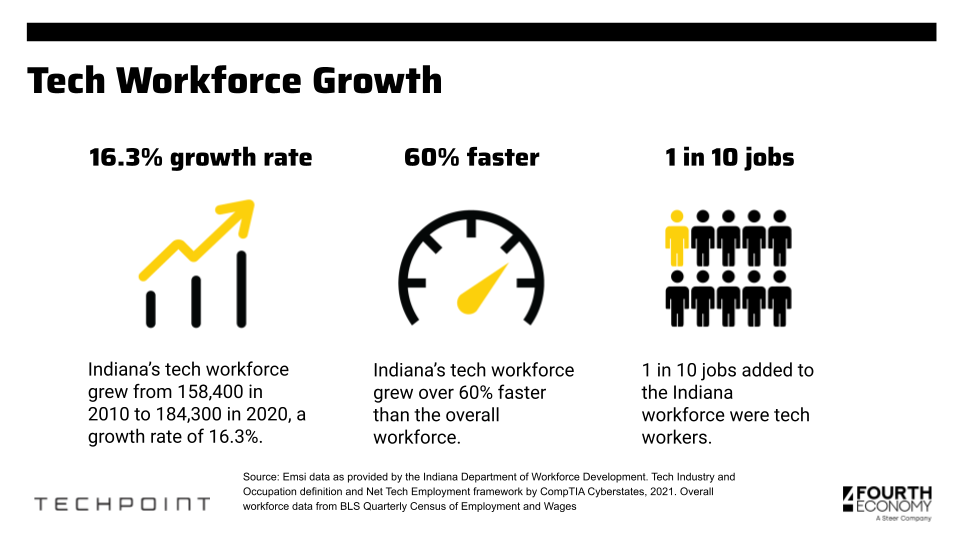
The tech workforce has grown by 16.3 percent over the past decade, a 60 percent faster growth rate than seen across other sectors. More than 184,000 Hoosiers now work in tech and tech-enabled roles, filling one out of every 10 jobs in Indiana.
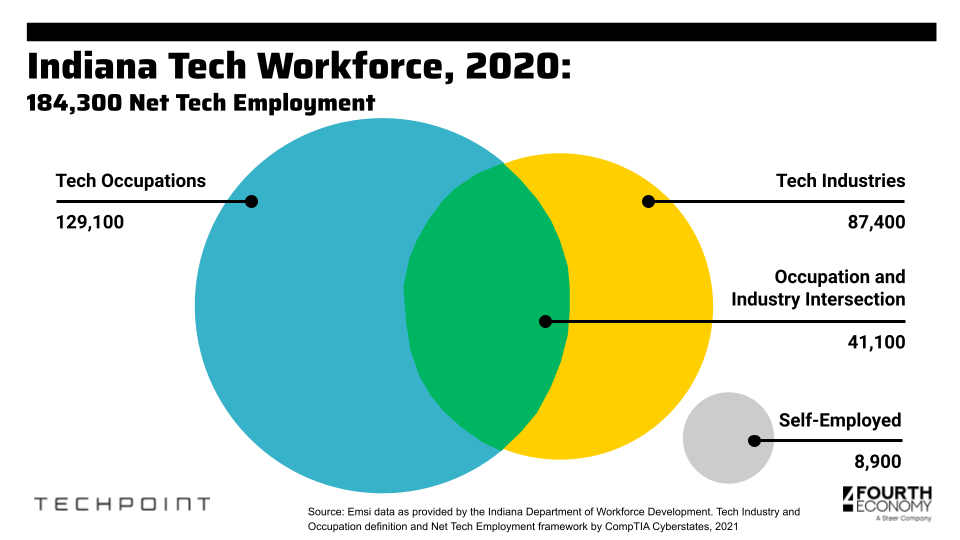
COVID Drives Growth and Adaptation
Lockdowns due to the COVID-19 pandemic caused an unprecedented wave of tech adoption for businesses across all industries. As companies learned to work remotely and connect with customers virtually, they essentially crammed a decade’s worth of tech adoption and digital transformation into a single whirlwind year. As Jeff Ton, president of the Indy CIO Network notes, “companies across all sectors now realize they need to reinvent themselves, that they need an immediate digitization strategy.”
New tech adoption also increased the need for employees who could help identify, execute, train and manage new tools while also inspiring next generation development of new tech to meet evolving and growing demand.
Another side effect of the pandemic is that employers realized they could be productive and still allow flexible work, even 100 percent remote workforces in some cases. Millions of employees now say they never want to return to office-tied, 9-to-5 jobs. Their pandemic-inspired new thirst for better work-life balance caused so many of them to look for jobs that better suited their wants and desires, with their mass actions referred to as “The Great Resignation.”
Nearly 60 percent of U.S. workers who say their jobs can be done from home are working from home all or most of the time out of choice rather than necessity according to a January Pew Research Center that surveyed about 10,000 Americans. Sixty-four percent of those who are working from home at least some of the time but rarely did before the pandemic say it’s easier now to balance work with their personal life. The Pew Research also notes a significant increase in the percentage of people who are working remotely because they relocated away from the area where they work – 17 percent compared to 9 percent in 2020.
The job market in general favors workers, but tech workers are in an even better position as estimates of the unemployment rates for tech workers reported by the New York Times are about 1.7 percent, compared with roughly 4 percent in the general economy; and for those with expertise in cybersecurity, it’s more like 0.2 percent. Tech employees are in such high demand that recruiters told the New York Times recently that tech employees are tired of being head-hunted.
CompTIA’s 2021 Workforce and Learning Trends report, showed 40 percent of companies hired new tech staff during the pandemic, and 66 percent have plans to add even more in 2022. Many of the changes brought by the pandemic aren’t going to disappear even when the pandemic gradually fades, which means companies will need to continue investing in tech and modernized ways of working to survive. Companies everywhere are figuring out how to make hybrid work permanent. And, digital channel adoptions such as telehealth and curbside grocery pickup are so overwhelmingly preferred by customers that many firms are putting permanent solutions in place.
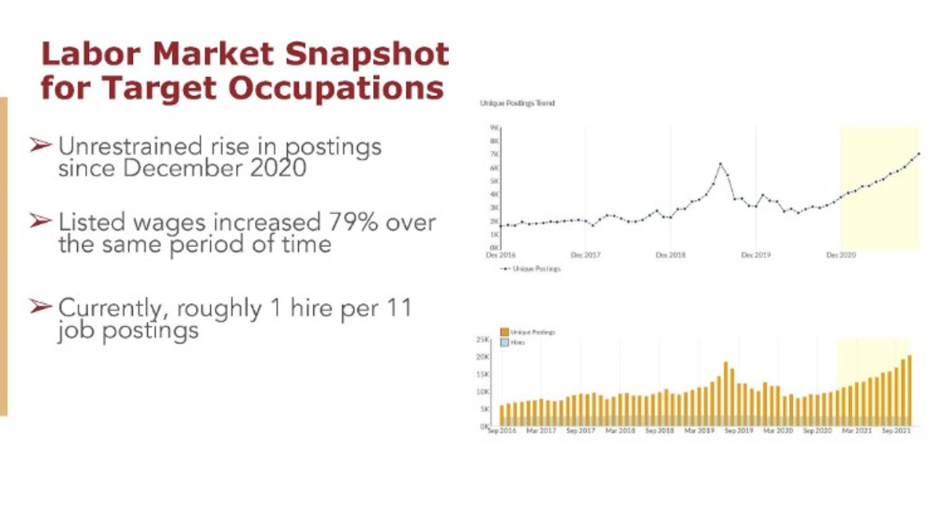
The Great Resignation Challenges Labor Markets
At the same time, the Great Resignation and the long-anticipated wave of Baby Boomer retirements have simultaneously reduced the number of tech talent workers in the workforce; Microsoft’s 2021 Work Trends Index found more than 40 percent of employees are considering making a job change. Wages are already increasing substantially. Indiana tech and tech-enabled employers are reporting that salaries have jumped 20-30 percent for most tech roles over the past two years.
Indianapolis-based DB Services has seen challenges in attracting out-of-state talent for remote positions. “Candidates from other states look to join Indiana companies as remote employees, and depending on what state they are located in, some candidates are looking for salaries that align with the cost of living for their own state and not Indiana,” said Ben Colter, HR generalist for DB Services.
Hoosier CEOs at a recent IBJ Tech Breakfast agreed that hiring tech is “a struggle” that now takes much longer than it used to and it requires new flexibility with work location as well as increased benefits.
Enrollment Cliff + Tech Talent Shortage = Perfect Storm
As if those challenges weren’t enough, the long-anticipated Baby Echo cohort has begun enrolling in higher education. This demographic group is the result of a decline in births due to the Great Recession of 2008, and it is projected to drop traditional college-age enrollments by 15 percent across Midwest colleges and universities for the coming decade. The pool of traditionally prepared, college-degreed talent that companies have relied upon is about to shrink considerably, precisely at the time of greatest demand. Together, COVID, the Great Resignation, and the College Enrollment Cliff are creating a perfect storm of talent demand and supply challenges for the IT workforce.
The Stakes for Indiana Tech Jobs are High and Rising Quickly
Clearly, the stakes for growing and aligning the tech talent pipeline are high. A recent Korn Ferry study found that unless we get more high-tech workers, by 2030, the U.S. could miss out on more than $160 billion of revenues annually.
Indiana’s economy would suffer across all sectors because the Digital Age has created a scenario where every company is a tech company, and reliance on tech workers will be felt by advanced manufacturing, logistics, life sciences and agriculture, the state’s biggest employment sectors. Tech is also one of Indiana’s fastest growing sectors, as recent research conducted by the Fourth Economy for TechPoint makes clear.
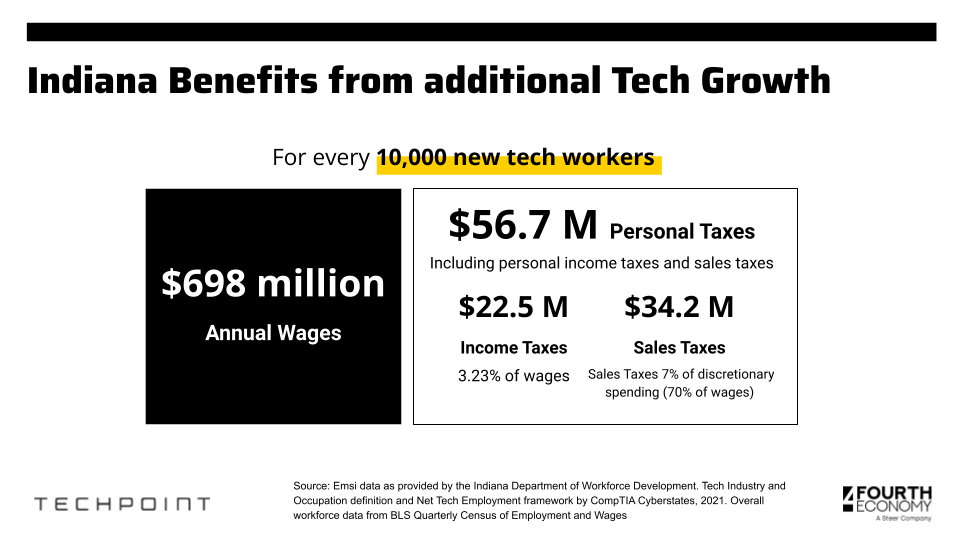
Tech jobs offer high salaries, stability and strong advancement pathways. The impact of growing the tech sector and tech talent is crystal clear. For every 10,000 new tech workers added to the Indiana workforce, $698 million in new annual wages are generated and $56.9 million in state and local tax revenues are gained.
Bold Goals and Collaborative Efforts Across the Tech Sector
As Albert Einstein has been paraphrased, “we cannot solve our current problems with our old ways of thinking.“ The perfect storm of innovation-driven demand, retirements and departures from the workforce, and declines in traditional college graduate numbers means that focusing on strategies primarily to attract talent will no longer work. If we maintain our current talent strategies, the study shows we would incrementally lose tech talent over the next several years, as new competition and demands weakens the impact of these tested approaches.
Our region simply can’t afford that outcome. The Indiana tech sector must identify, align around, and undertake innovative new strategies for growing the tech and tech-enabled workforce. In order to exceed the results of natural attrition and grow the workforce to meet demand, Indiana must double the national tech workforce growth rate by 2030.

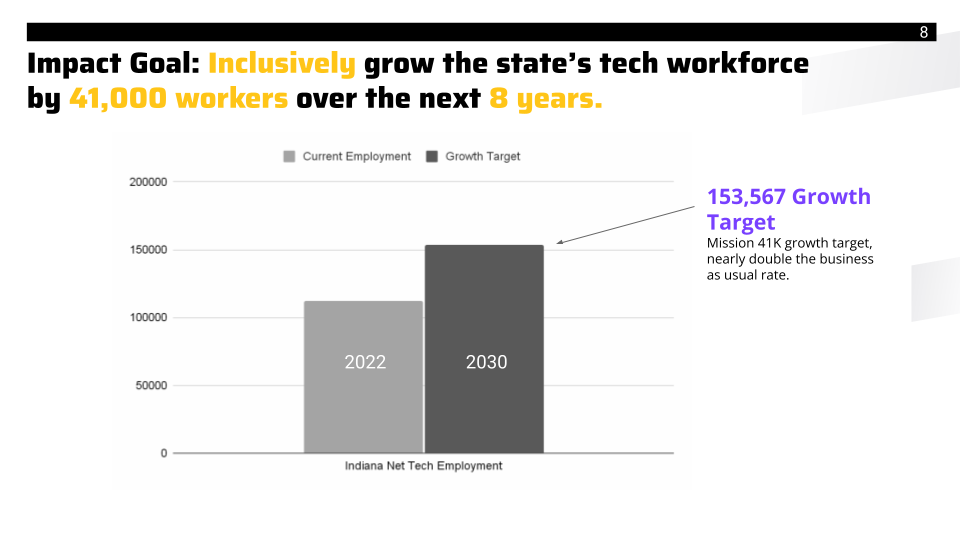

Salesforce is an example of a large tech employer with a significant Indianapolis presence (its second-largest Salesforce Tower location) that already recognizes the necessity to iterate talent-nurturing initiatives to set the tech sector and its own workforce up for success tomorrow. The company’s Pathfinder Program provides free, immersive training on Salesforce software to learn in-demand skills, earn Salesforce credentials, and make connections with mentors and the Salesforce community. Participants train with experienced Salesforce instructors, get hands-on with Trailhead, Salesforce’s online learning platform, and complete practical case studies, while also learning the business skills to pursue Salesforce ecosystem jobs as admins, developers, analysts, consultants, and more. Pathfinder is a pathway for anyone–regardless of age or educational background–to make their way into in-demand tech jobs.
How Indiana Can Win the Race for Talent
Indiana has a strong talent pool and rich talent development assets like TechPoint and Indiana’s leading universities and colleges. It also has a reputation as a business-friendly state, and Hoosiers are famously friendly and hospitable.
Al Eisaian, past CEO of Intelinair, who moved his California-founded ag-tech company to Indiana, recently credited those attributes as the basis for his relocation. At an Indianapolis Business Journal Power Breakfast, he acknowledged hiring challenges, but said Indiana should be a “net-gainer” when it comes to remote workers because of its friendly and supportive environment. He agreed, though, that traditional talent attraction methods aren’t enough for Indiana to thrive in the coming years.
“We have to offer additional on-ramps otherwise we’re just constantly stealing people from each other,” he said, advocating apprenticeship programs and other initiatives aimed at encouraging young people, especially those from historically under-represented groups, to go into tech careers.
Companies Must Modernize Talent Pathways
TechPoint and its member companies are already starting to explore and reimagine training for tech talent. Even with well-publicized efforts by many companies to make their hiring more inclusive, the sort of workers that command higher tech salaries are still frequently limited to those with college degrees and years of what industry leaders consider to be the most relevant experience. Fortunately, COVID demands have shifted this mind-set, and many human resources (HR) professionals now support eliminating the four-year degree requirement for many positions. HR leaders are also beginning to recognize the importance of shifting from degree-focused job descriptions to descriptions focused on necessary foundational and occupational competencies. These foundational shifts are critical to opening up new pathways to tech careers. This will especially help open pathways for non-traditional candidates, who often cannot envision themselves in tech and/or see no clear path for entry-success in key technical roles.
Diversity, Equity and Inclusion (DEI) Work is Essential
Achieving a well-skilled tech workforce with an additional 41,000+ Hoosier tech workers by 2030 will require a focus on creating a more diverse, inclusive and supporting tech sector. As the numbers below indicate, Indiana’s participation rate in the tech sector by women, Black and LatinX workers significantly trails participation rates in the overall Indiana workforce. Community work, new programs and cultural perspective shifts are required to close these gaps, but doing so will be absolutely essential to Indiana’s mid-term and long-term ability to grow the tech workforce by 2030.
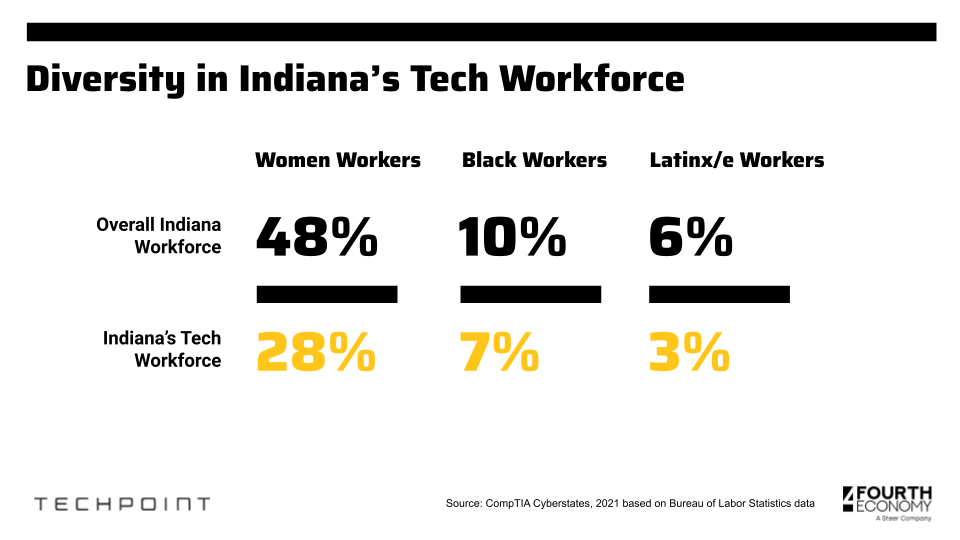
Partnering for Collective Impact on Indiana’s Tech Workforce
Recognizing that it is a defining moment for talent innovation, TechPoint is embracing the challenge of catalyzing and leading the charge to grow Indiana’s tech workforce. It’s our Mission41K, and it’s a mission shared with many partners and stakeholders in both the private and public sectors.
Meeting Indiana’s workforce needs will require more than incremental growth through previously tested approaches. It will take new programs, vital pathway and alignment work, and initiatives to attract and support historically underrepresented groups. It will take culture work. Most importantly, it will take collaborative action to reach the shared goal of growing the tech workforce that Indiana needs by 2030.

This will not be easy work. It will take consistent and coordinated effort over the coming decade, but TechPoint is committed to working with key corporate, community and civic stakeholders through convenings, shared information, close collaborative conversations and other means to align around our best paths forward.
In future articles of this TechPoint Index series, we will be sharing more fundamental research to shape your understanding, as well as information on how you and your organization can engage and contribute. We are confident that with the collective help and collaboration of Indiana’s incredible tech ecosystem along with state and local leaders, Indiana can win the race for talent.
As TechPoint’s former CEO Mike Langellier pointed out at an IBJ Power Breakfast, Indianapolis is a mid-sized city acknowledged as “a legit tech hub.” The city and the state overall are attractive to people wanting to escape the cost and congestion of the larger tech hubs and cities.
Providing more pathways into tech careers and innovative ways to grow tech talent, coupled with wooing more remote workers to Indiana will ensure Indiana wins, he said.
“If Indiana can win in attracting and developing talent, it’s game over; we win.”
For more comprehensive data about Indiana workforce trends as well as summaries of ecosystem stakeholder interviews that informed TechPoint’s strategic plan process, please view the TechPoint Strategic Plan Executive Summary entitled “Charting the next chapter for TechPoint and Indiana’s tech ecosystem.”






